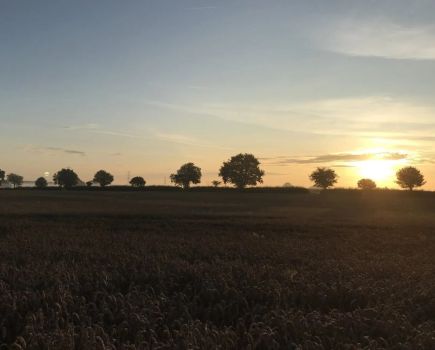There’s a lot of talk about carbon farming but what’s it really all about? CPM attended the AICC conference earlier this year to try and find out.
Work with someone in the same county rather than someone the other side of the world.
By Rob Jones
Carbon was high on the agenda at the recent Association of Independent Crop Consultants (AICC) annual technical conference, as members and guests learned how it should be managed to benefit businesses, biodiversity, and the wider environment.
Climate change is a reality, with weather records being broken with regularity over recent years, and this is widely agreed to be largely driven by increases in atmospheric carbon emitted by human activity.
This has prompted governments around the world to set net zero targets, committing their nations to move toward the situation where they’re capturing the same or more carbon from the atmosphere than they emit, and in most cases aiming to do so by 2050.
The NFU has been even more ambitious with its target for UK agriculture and its supply chains, pledging to hit net zero as an industry a decade earlier by 2040.
It’s frequently said that farmers and landowners are uniquely placed to help meet these targets, as they have the potential to help individuals or companies offset emissions. This could provide a valuable revenue stream at a time when costs of production are rising, and support payments being cut in sweeping reforms, so it’s something that has come to the fore recently.
So how might a farm go about trading carbon or biodiversity credits once they’ve been certified? That’s a question Gary Styles of Zellar is hoping to answer with a new community platform, he told the conference delegates.
The company’s aim is to allow small businesses to practice climate action in an easy and accessible way and become sustainable by 2030, he said.
Put simply, its platform allows a user to build a profile that outlines a strategy and action plan for sustainability and a current sustainability score. The profile is then searchable and visible to the outside world, creating a peer-to-peer marketplace for likeminded businesses, with farmers receiving 97% of the value of each project sold on Zellar’s peer-to-peer marketplace, explained Gary.
The platform was launched in Manchester last September and has already connected businesses in the city with landowners and farmers around its outskirts, allowing them to invest in carbon capture and biodiversity schemes, he said.
“I’m confident this will be the most efficient and profitable route to market for landowners,” said Gary.
But before farmers or landowners can trade carbon or biodiversity credits, they first need to understand their own carbon footprint and AICC members and industry guests heard how another digital platform might help.
Trinity AgTech’s Alasdair Sykes worked through its Sandy digital platform, which uses the farm’s data – drawn from existing systems like Gatekeeper, Excel and manual entry – to calculate its carbon footprint.
After calculating the farm’s present status, Sandy then uses algorithms to produce recommendations on how to reach net zero; identifying areas where emissions might be cut, such as improving nitrogen-use efficiency; or sequestration measures to put in place.
“We also bring in gross margin data. Everything we’re doing isn’t just thinking about the farm’s sustainability and getting to net zero, but also closely considering the farm’s profitability and the cost involved,” said Alasdair.
On top of emissions, an additional Sandy module scores a user’s business for biodiversity using five metrics, including farmland wildlife, natural enemies, conservation species, pollinators, and soil biodiversity.
Other modules include water protection and nitrogen uptake efficiency analysis engine. Scores are between one and five, with five being the highest, and this allows the land manager to see the impact that certain practices have on each metric, he explained.
“We help the user to break that down, so we can effectively identify where the hot and cold spots are for biodiversity and understand where changes can be made.”
There are over 70 carbon calculators available worldwide, and he was asked how farmers go about choosing the right one.
Alasdair pointed out that the pool becomes much smaller when delving a bit deeper into the credibility of the science underpinning the systems, as it can vary significantly. But that’s just one of two important considerations when choosing a carbon calculator, he believes.
The second is ease of use and Alasdair believes Trinity has managed to achieve this by making good use of new generation technologies and existing data, which reduces laborious data entry as part of the process from start to finish during a carbon footprint analysis.
This also ensures that the carbon footprint is aligned with other key environmental metrics like biodiversity and nitrogen uptake efficiency, he said.
A farmer who has gone through the process of carrying out a carbon audit on his own farm is John Miller, who farms 666ha near Newark-on-Trent in Nottinghamshire.
He recently developed an interest in regenerative agriculture and has been introducing different techniques and products into his arable system to improve soil and plant health and reduce reliance on chemical inputs.
The business is almost ready to enter emerging carbon credit markets after assessing its carbon status using Danish agtech platform Agreena, formally known as Commodicarbon.
John said one of the most important considerations for him before starting were the credibility of the other parties involved, and the carbon credit certificates themselves, once finalised.
Agreena use another Danish company, Agrovi, for practical farm consultancy, plus remote surveillance by Hummingbird and Norwegian firm DNV – who specialise in auditing and certification – to ensure land managers are sticking to obligations.
This results in carbon credit certificates that abide by the ISO14064 standard and are placed on a register for buyers to purchase with confidence, he said.
The farm carried out an assessment of its carbon footprint in the 2020-21 cropping year and because of the regenerative measures adopted on the farm, his wheat production is already very close to net zero.
“I think if we were to reduce nitrogen rates from 170kgN/ha to 150kgN/ha, we would pretty much be there,” he added.
John hasn’t got his carbon credit certificates yet but expects them to be confirmed soon. These will not be sold straight away and instead he will wait to see what happens with the market value, he told delegates.
The business may even utilise the certificates to add value to its produce, selling to processors wishing to label products as ‘made with carbon neutral wheat or oats’, he added.
A big question on many lips is who should farmers or landowners be selling their carbon credits to? There’s concern that some companies will be ‘greenwashing’ its activities without making concerted efforts to reduce their own emissions.
John said that sellers must make sure that buyers are credible and ideally, connect with local companies where possible.
“Work with someone in the same county rather than someone the other side of the world,” he added.
Companies like Zellar are also trying to address this issue on its platform, which only connects buyers with sellers if they are using 100% renewable electricity within their businesses, for example.
There’s some hesitancy amongst farm businesses about getting involved in carbon trading and this is understandable given the novelty of the markets and myriad companies scrambling for a slice of the pie, said AICC chairman and Lincolnshire agronomist Sean Sparling.
He sees carbon capture, emissions reductions and potentially carbon trading as being as fundamental to arable farming as integrated pest management (IPM) has always been.
He said it’s the direction of travel, signposted by the 2040 and 2050 targets from the NFU and government, so getting involved with agtech platforms that facilitate carbon auditing and trading is a sensible move.
Sean agreed with the ‘take control’ message that’s being touted by many involved in carbon markets, though his perspective may be slightly different. “The worst thing to do is to do nothing for 20 years, when 2040 or 2050 is looming and these things will be forced on people anyway. We have to get involved now and improve understanding of our impact on the wider landscape. Are we emitting or are we sequestering carbon?”




